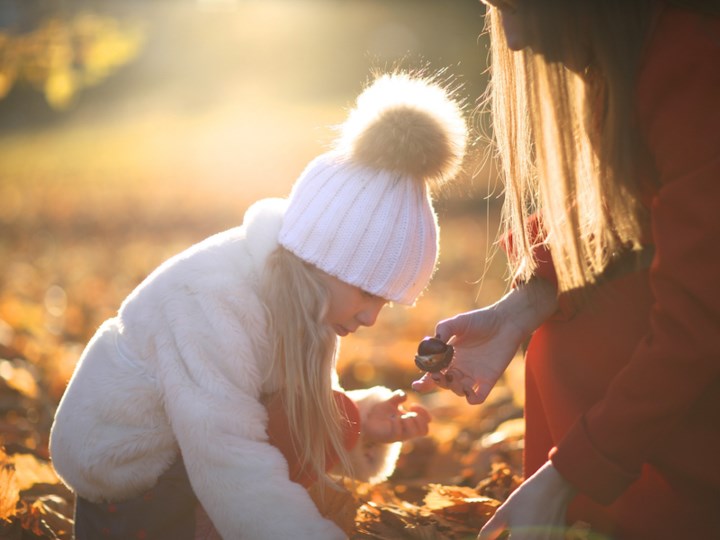Even when the summer is over and the next one still far out of sight, there are still plenty of reasons to come to Croatia, and spend a
magnificent autumn break in one of our
beautiful villas with pool in Istria or the Kvarner Region.
Autumn is a vivid time of the year, with
manifestations and festivals, as nature is bountiful in fruits and many delicacies.
The chestnut is definitely one of autumn's highlights :) The prickly peel hides a truly versatile
delicacy!
The chestnut tree provides us with these magnificent nuts, which might evoke
childhood memories in many of us, and warm feelings from remembering
roasting this delicacy on coldish autumn evenings. To be noted, that wild (horse) chestnuts are not edible for humans, as opposed to the “cultivated” edible ones.

However, not to limit the
abundant qualities of the chestnut just to roasting (even though I prefer this variety of it the most :) let me mention a few more facts about this
delightful nut.
Chestnut forests are well represented in Croatia and extend mainly along the entire continental Croatia and throughout
Istria and Kvarner region.
In some regions in Croatia you will hear them called
maruni, which is a variety of cultivated chestnuts, lighter in colour than ordinary chestnuts, bigger and usually sweeter.
Due to its abundance and quality, chestnuts have left a
strong mark in the gastronomy of the areas where they thrive. To mention the health aspect of the chestnut - it is
nutritionally high-value food and even contains a lot of vitamin C. They are used from ancient times in preparing various dishes,
roasted or cooked as a standalone dish or prepared as a puree (
kesten pire), in soups, fillings, as an addition to various cakes, desserts and side-dishes. It is also used to make
honey and flour. Since it does not contain gluten, it can be used to prepare gluten-free food. Did you know, that in the past roasted and then ground chestnuts served even as a
coffee substitute? You might want to try it!
 A special chestnut variety
A special chestnut variety (
maruni ) grows only on the slopes of
Ucka mountain range on the eastern side of the Istrian peninsula, mostly in the areas
around Opatija, Lovran and Moscenicka Draga.
The small town of Lovran, close to the sea and in the vicinity of Opatija, is especially known for its
quality chestnuts, which originate from crossing domestic wild chestnuts and seedlings brought by Lovran sailors from some of the countries of the Far East, probably from Japan. Due to its quality, they had been
exported since the 17th century and reached popularity in the 19th century - chestnut produce from this area was sought after in Italy, Germany and Austria.
If you are spending your holiday in the Kvarner region during October, be sure to visit
Marunada, the traditional Lovran Chestnut Festival, one of the most famous of its kind in Croatia, since 1973. Besides trying out so many
varieties of chestnuts, in sweets, savoury dishes, or just roasted - there is
folklore, sports events and other traditional specialties of this area. It is even known internationally and listed in the British The Guardian, as one of the gastronomic events that
should not be missed.
Another chestnut related event worth visiting while in Istria, is definitely the
Kestenijada (
kesten meaning
chestnut in Croatian), held also in October in the
small hilltop town of Oprtalj, in northwestern Istria. Oprtalj is also known as the
Town of Chestnuts. The surrounding area is abundant with chestnut forests (locally called kastanji). The chestnuts from these forests are smaller in size than the maruni in Lovran, but are said to be
sweeter :)
 Kestenijada
Kestenijada is a
traditional event dedicated to the chestnut and its produce, various cakes, honey. Alongside there are various
entertainment programs for children and music.
For a simple but delicious chestnut
gourmet experience, I would suggest roasting /baking them: you can roast them in the oven or in a
pan. Ripe chestnuts need to be cut so that they do not burst during baking and so that they can be peeled off more easily later. Just make a small incision across the chestnut. For
baking in the oven, first put them in cold water and boil them in salt water for a bit. Then put them in the oven for 20 min. When they are done (once they are dry) take them out and put them in a dry dish-cloth for about 15 min - this way you will be able to
peel them better :) If you want to use a pan - same procedure, without previously boiling them. You can cover the pan or not.
Cooking the chestnuts will give you the main ingredient for the
heavenly dessert “kesten pire” (chestnut puree): Put them in a pot with cold water (just enough to cover the chestnuts), add a little salt and put on the stove to cook for 20-30 minutes, depending on the size of the chestnuts. Blend the cooked chestnuts with some sirup made from water and sugar, add some vanilla flavour and rum if you like. Puree it, put into small bowls and add some whipped cream on top.
Delicious!
Chestnut picking is an ideal fun activity for the whole
family or a group of friends, while spending your autumn holiday in one of our
villas with pool in Central Istria or the Kvarner region. Imagine roasting your handpicked chestnuts in the villa of your choice, on a
magical autumn evening, beneath the stars. Wouldn't this be a good choice for your autumn holiday in Croatia? :)
Natalie Sipak
30.9.2022

 MY ISTRIA GUIDE
MY ISTRIA GUIDE



